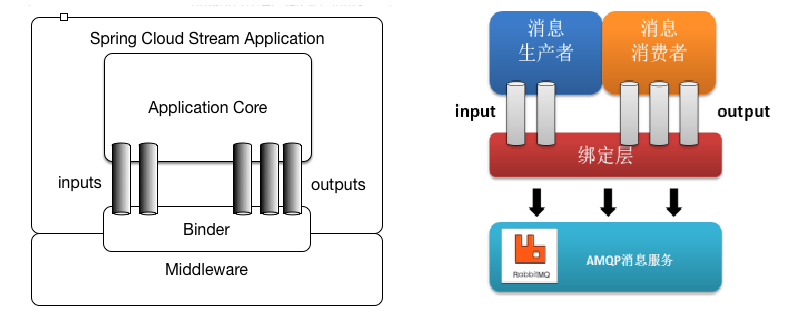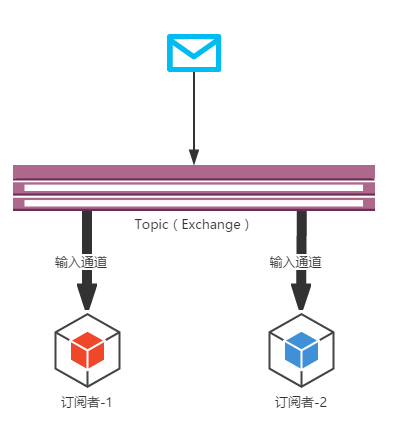在实际的企业开发中,消息中间件是至关重要的组件之一。消息中间件主要解决应用解耦,异步消
息,流量削锋等问题,实现高性能,高可用,可伸缩和最终一致性架构。不同的中间件其实现方式,内
部结构是不一样的。如常见的RabbitMQ和Kafka,由于这两个消息中间件的架构上的不同,像
RabbitMQ有exchange,kafka有Topic,partitions分区,这些中间件的差异性导致我们实际项目开发
给我们造成了一定的困扰,我们如果用了两个消息队列的其中一种,后面的业务需求,我想往另外一种
消息队列进行迁移,这时候无疑就是一个灾难性的,一大堆东西都要重新推倒重新做,因为它跟我们的
系统耦合了,这时候 springcloud Stream 给我们提供了一种解耦合的方式。
概述
Spring Cloud Stream由一个中间件中立的核组成。应用通过Spring Cloud Stream插入的input(相当于
消费者consumer,它是从队列中接收消息的)和output(相当于生产者producer,它是从队列中发送消
息的。)通道与外界交流。通道通过指定中间件的Binder实现与外部代理连接。业务开发者不再关注具
体消息中间件,只需关注Binder对应用程序提供的抽象概念来使用消息中间件实现业务即可。 
说明:最底层是消息服务,中间层是绑定层,绑定层和底层的消息服务进行绑定,顶层是消息生产者和
消息消费者,顶层可以向绑定层生产消息和和获取消息消费
绑定器
Binder 绑定器是Spring Cloud Stream中一个非常重要的概念。在没有绑定器这个概念的情况下,我们
的Spring Boot应用要直接与消息中间件进行信息交互的时候,由于各消息中间件构建的初衷不同,它
们的实现细节上会有较大的差异性,这使得我们实现的消息交互逻辑就会非常笨重,因为对具体的中间
件实现细节有太重的依赖,当中间件有较大的变动升级、或是更换中间件的时候,我们就需要付出非常
大的代价来实施。
通过定义绑定器作为中间层,实现了应用程序与消息中间件(Middleware)细节之间的隔离。通过向应用
程序暴露统一的Channel通过,使得应用程序不需要再考虑各种不同的消息中间件的实现。当需要升级
消息中间件,或者是更换其他消息中间件产品时,我们需要做的就是更换对应的Binder绑定器而不需要
修改任何应用逻辑 。甚至可以任意的改变中间件的类型而不需要修改一行代码。
Spring Cloud Stream支持各种binder实现,下表包含GitHub项目的链接。
RabbitMQ
Apache Kafka
Amazon Kinesis
Google PubSub (partner maintained)
Solace PubSub+ (partner maintained)
Azure Event Hubs (partner maintained)
通过配置把应用和spring cloud stream 的 binder 绑定在一起,之后我们只需要修改 binder 的配置来
达到动态修改topic、exchange、type等一系列信息而不需要修改一行代码。
发布/订阅模型
在Spring Cloud Stream中的消息通信方式遵循了发布-订阅模式,当一条消息被投递到消息中间件之
后,它会通过共享的 Topic 主题进行广播,消息消费者在订阅的主题中收到它并触发自身的业务逻辑处
理。这里所提到的 Topic 主题是Spring Cloud Stream中的一个抽象概念,用来代表发布共享消息给消
费者的地方。在不同的消息中间件中, Topic 可能对应着不同的概念,比如:在RabbitMQ中的它对应
了Exchange、而在Kakfa中则对应了Kafka中的Topic。

案例中通过rabbitMQ作为消息中间件,完成SpringCloud Stream的案例。需要自行安装
消息生产者
(1)创建工程引入依赖
<dependencies> <dependency> <groupId>org.springframework.cloud</groupId> <artifactId>spring-cloud-stream</artifactId> </dependency> <dependency> <groupId>org.springframework.cloud</groupId> <artifactId>spring-cloud-starter-stream-rabbit</artifactId> </dependency> <dependency> <groupId>org.springframework.cloud</groupId> <artifactId>spring-cloud-stream-binder-rabbit</artifactId> </dependency> </dependencies>
(2)定义bingding
发送消息时需要定义一个接口,不同的是接口方法的返回对象是 MessageChannel:
/** * 自定义的消息通道 */ public interface MyProcessor { /** * 消息生产者的配置 */ String MYOUTPUT = "myoutput"; @Output("myoutput") MessageChannel myoutput(); /** * 消息消费者的配置 */ String MYINPUT = "myinput"; @Input("myinput") SubscribableChannel myinput(); }
/** * 负责向中间件发送数据 */ @Component @EnableBinding(MyProcessor.class) public class MessageSender { @Autowired @Qualifier(value="myoutput") private MessageChannel myoutput; //发送消息 public void send(Object obj) { myoutput.send(MessageBuilder.withPayload(obj).build()); } }
yml清单
server: port: 7001 #服务端口 spring: application: name: stream_producer #指定服务名 rabbitmq: addresses: 192.168.180.137 username: guest password: guest cloud: stream: bindings: output: destination: topcheer-default #指定消息发送的目的地,在rabbitmq中,发送到一个topcheer-default的exchange中 myoutput: destination: topcheer-custom-output # producer: # partition-key-expression: payload #分区关键字 对象中的id,对象 # partition-count: 2 #分区大小 binders: #配置绑定器 defaultRabbit: type: rabbit
消息消费者
(1)创建工程引入依赖
<dependencies>
<dependency>
<groupId>org.springframework.cloud</groupId>
<artifactId>spring-cloud-stream</artifactId>
</dependency>
<dependency>
<groupId>org.springframework.cloud</groupId>
<artifactId>spring-cloud-starter-stream-rabbit</artifactId>
</dependency>
<dependency>
<groupId>org.springframework.cloud</groupId>
<artifactId>spring-cloud-stream-binder-rabbit</artifactId>
</dependency>
</dependencies>
2)定义bingding
同发送消息一致,在Spring Cloud Stream中接受消息,需要定义一个接口。
/** * 自定义的消息通道 */ public interface MyProcessor { /** * 消息生产者的配置 */ String MYOUTPUT = "myoutput"; @Output("myoutput") MessageChannel myoutput(); /** * 消息消费者的配置 */ String MYINPUT = "myinput"; @Input("myinput") SubscribableChannel myinput(); }
@Component @EnableBinding(MyProcessor.class) public class MessageListener { //监听binding中的消息 @StreamListener(MyProcessor.MYINPUT) public void input(String message) { System.out.println("获取到消息: "+message); } }
yml清单
server: port: 7002 #服务端口 spring: application: name: rabbitmq-consumer #指定服务名 rabbitmq: addresses: 192.168.180.137 username: guest password: guest cloud: stream: # instanceCount: 2 #消费者总数 # instanceIndex: 0 #当前消费者的索引 bindings: input: #内置的获取消息的通道 , 从topcheer-default中获取消息 destination: topcheer-default myinput: destination: topcheer-custom-output # group: group1 # consumer: # partitioned: true #开启分区支持 binders: defaultRabbit: type: rabbit


测试类:
@RunWith(SpringJUnit4ClassRunner.class) @SpringBootTest(classes = ProducerApplication.class) public class Test { @Autowired(required = false) private MessageSender messageSender; @org.junit.Test public void toSend(){ messageSender.send("测试"); } }





















 7518
7518











 被折叠的 条评论
为什么被折叠?
被折叠的 条评论
为什么被折叠?








